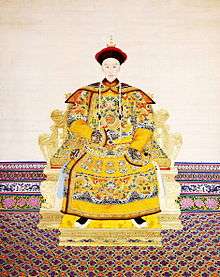Yellow Dragon

The Yellow Dragon (traditional Chinese: 黃龍; simplified Chinese: 黄龙; pinyin: huáng lóng; Cantonese Yale: wong4 lung4; Japanese: Kōryū or Ōryū; Korean: Hwang-Ryong; Vietnamese: Hoàng Long) is a creature in Chinese mythology.
History
According to legends it once emerged as a hornless dragon from the River Luo and presented the legendary Emperor Fu Xi with the elements of writing. When it appeared before Fu Xi, it filled a hole in the sky made by the monster Gong Gong. Its waking, sleeping, and breathing determined day and night, seasons, and weather.
The legendary Yellow Emperor was sometimes said to have transformed into a dragon that resembled his emblem and ascended to Heaven. Since the Chinese consider him to be their ancestor, they sometimes refer to themselves as "the children of the dragon". This legend also contributed towards the use of the Chinese dragon as a symbol of imperial power.
The Chinese national flag from 1889-1912 is also called the Yellow Dragon Flag (simplified Chinese: 黄龙旗; traditional Chinese: 黃龍旗; pinyin: huáng lóng qí).
The Yellow Dragon Sports Center is named in its honour.
Other uses
In East Asian culture, there is sometimes a fifth Guardian Beast of the Si Xiang. This deity is the guardian of the center and it represents the element earth, the Chinese quintessence, as well as the changing of the seasons.
The yellow dragon does not appear in Japanese mythology: the fifth element in the Japanese elemental system is Void, so there cannot be an animal representing it. Because of this, the yellow dragon is often forgotten. However, some consider the Ouryu (Ōryū, yellow dragon) as the Japanese counterpart of the dragon since they share some similarities.
See also
| ||||||||||||||||||||||||||||